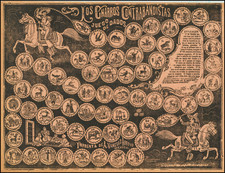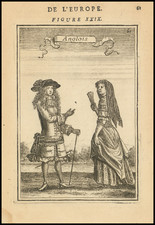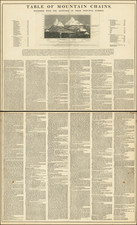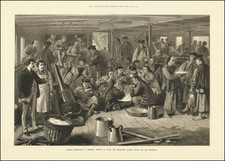Unfinished drawing of what appears to be a Hunkpapa Lakota Woman ( although it also looks a bit like Sitting Bull), apparently signed by German artist Friedrich Hagedorn.
The drawing was acquired in 2020 from a German Auction House in a pair with second Hagedorn drawing of Walking Shooter, a Hunkpapa Lakota, and likely drawn from a photo taken circa 1872. . https://www.raremaps.com/gallery/detail/67048.
As noted below, the German born Hagedorn was the court painter in Lisbon before moving to Brazil in 1848, where he lived and worked for 20 years, before returning to Germany in the late 1860s.
We were not able to find other drawings of American Indians by Hagedorn, but the drawing is consident with the German fascination with American Indians during the 19th Century. The first actual American Indians came to Germany in the 19th century. Kah-ge-ga-ga-bow, an Ojibwa born in 1819, baptized as Reverend George Copway, took part in the 1850 World Peace Congress at St. Paul's Church, Frankfurt am Main. The image of the warrior turned Christian went down well with the public and Conway became a media star in Germany.[Henry Wadsworth Longfellow recommended him to the leftist poet Ferdinand Freiligrath.
Other Native Americans arrived with human zoos and took part in shows in zoological gardens and circuses. In 1879 Carl Hagenbeck (1844–1913) engaged among others some Iroquois for a show in Dresden. Painter and author Rudolf Cronau, a personal friend of Sitting Bull, invited members of the Hunkpapa Lakota, who came to Europe in 1886. Buffalo Bill's European shows in 1890 and between 1903 and 1907 involved several hundred Indians and were quite popular in Germany. Edward Two-Two, a Lakota-Sioux, worked at the Sarrasani circus in Dresden in 1913/14 and was buried there in 1914 according to his wishes.
Hagedorn served as a court painter in Lisbon between 1844-1847, then settled in Rio de Janeiro from 1848 to 1853,completing a group of German artists who have documented the landscape and the national customs, traveling to Pernambuco, São Paulo, Bahia and Minas Gerais.
He first established his atelier at Rua São José Number 12. Later he moved to Rua do Teatro, Number 17. He took part in the Exposição Geral de Belas-Artes in 1859–1860.
He remained in Brazil for twenty years, working in Niterói, Petrópolis, Teresópolis, Juiz de Fora, Salvador and Recife. Although he found a good market for his productions, his presence seems to have been little noticed by the official circles and art critics of the time.
He worked specially with watercolor and tempera, and some of his landscapes were disseminated through Chromolithographs. His work is preserved mainly in the Hispanic Society of America, in New York, the National Library of Brazil, the Museu do Estado de Pernambuco, as well as in private collections.









![[The centre of this Slider is to be placed by a Thread or Pin over the centre of the respective Planisphere for any Operation]](https://storage.googleapis.com/raremaps/img/small/65557.jpg)



![[ American Races ] Amerikanische Völkertypen](https://storage.googleapis.com/raremaps/img/small/104155.jpg)
